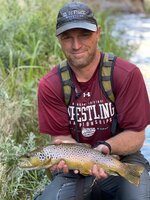Ok, so I’ve finally started catching trout on my fly rod, pretty consistently. I’m fishing in the gsmnp and from my understanding, the fish I’m catching are the average size for the park. That’s fine and dandy, but how do I catch the above average fish?
some things I’m currently considering are, matching the food sources more accurately, and focusing in on deeper bottle necks in the rivers that seem to provide a better supply of food and cover.
Here are some things to try:
1. This one seems obvious, but fish rivers known to hold above-average fish. Many creeks just don't have the food or temperature regime to grow them, and those can still be great fun, but if you're aiming for size make sure you're targeting waters where it's possible.
2. Dry flies are fun and can be effective on big fish in certain situations, especially during hatches of large flies. Learning the bugs and matching the hatch can make a real difference then. (My website troutnut.com is meant to help with that.) However, most of the time, subsurface presentations (nymphs and streamers) are the best way to catch bigger fish. Streamers are an especially beginner-friendly way to target only the big ones, but you'll catch a lot more fish--large and small--with nymphs. However, beginners are always waaaaay too casual about how they present their nymphs. Trout eat mostly nymphs, because that's that's mostly what they see, but they won't always move very far for a nymph. Your success rate will depend enormously on getting your nymph down to the fish's level, drifting it very close to the fish, and being able to detect very subtle strikes.
3. Cover as much ground as you can in a day of fishing. It depends a little bit on the technique you're using, but especially with dry flies you're targeting the smallest, most active percentage of fish in the pool, and you'll catch more if you move quickly and catch the most eager ones in every pool than if you try to fish each pool very thoroughly. However, one exception is if you're catching fish nonstop--sometimes you have to get a few small ones out of the way first before your fly even gets to the big ones.
4. Get away from easy access points and people, especially if it's common for people to keep trout there. Parking somewhere without a nearby river access, where you have to hike a hundred yards or more through woods with no trail to reach the water, can put you in some really good spots. You can use tools like Google Earth and OnX to find these.
5. Speaking of those tools, you can e-scout for trout just like elk, deer, etc. Look for big, deep pools with at least some areas of strong current (not long stretches of sluggish deep "frog water") and ideally some good cover like a logjam. From a very high-up, low-resolution view, look for very sinuous areas of the stream (lot of twists and turns), which tend to have good pools at the bends.
6. Another hunting tactic you can adapt for big trout is spot-and-stalk. You can learn to spot big fish on the bottom from good vantage points, and it's also not a bad idea to develop the habit of watching a promising pool for rises for a few minutes as you approach.
Each of these points could be a whole book chapter, or a whole book, when you really dive into the details. That's what makes fly fishing so great. But if I could recommend just one book that covers a lot of the most important stuff, get Tactical Flyfishing by Devin Olsen. There's a heavy focus on tight-line "Euro" nymphing, which is a fantastic but fairly specialized technique, but it'll teach you a lot about every aspect of fly fishing.

